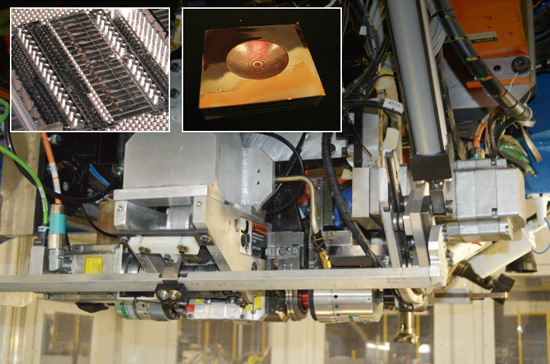When we talk about 3D printing, it is a catch-all phrase that encompasses several distinct technologies, each with its own strengths. Here are some comparisons of additive manufacturing options in plastic, metal and composites:
3D Printed Plastics
Fused Deposition Modeling (FDM)
Standard Materials: ABS
Relative Cost: ★★☆☆☆
Machine Finish: ★★☆☆☆
ABS Prime Finish: ★★★★★
Typical Lead Time: 2-5 Business Days
Specialty Materials: PC, nylon, ULTEM and many more (See FDM page)
Relative Cost: ★★★★☆
Machine Finish: ★★☆☆☆
Typical Lead Time: 3-7 Business Days
FDM Pros: Very high accuracy on large parts, diverse materials, rigid and tough, fast turnaround, sparse fill for light weight with high part volumes
FDM Cons: Striated machine finish, low resolution on features under 0.030"
Polyjet (Objet) Printing
Learn more about Polyjet
Standard Materials: Acrylic and polypropylene-like
Relative Cost: ★★★☆☆
Machine Finish: ★★★★★
Typical Lead Time: 2-5 Business Days
Specialty Materials: ABS-like, various elastomers and digital materials (See Polyjet Page)
Relative Cost: ★★★★☆
Machine Finish: ★★★★★
Typical Lead Time: 3-7 Business Days
Polyjet Pros: Top quality detail, best surface finish, clear material option, embedded textures, fine features, single piece mechanical assemblies
Polyjet Cons: Resins - not industrial thermoplastics, lower heat resistance, better for smaller parts
Selective Laser SIntering (SLS)
Learn more about SLS
Standard Materials: Nylon and glass filled nylon
Relative Cost*: ★★★☆☆
Machine Finish: ★★★☆☆
Typical Lead Time: 5-10 Business Days
Specialty Materials: Rubber (TPU), carbon filled nylon and other composites (See SLS page)
Relative Cost: ★★★★☆
Machine Finish: ★★★☆☆
Typical Lead Time: 5-10 Business Days
SLS Pros: Real thermoplastic and thermoplastic composites, uniform matte finish, great thermal and mechanical properties
SLS Cons: Large and thick parts can warp, longer production lead times, porous material, low resolution on features under 0.030"
*In volume SLS can become one of the least expensive printing processes.
Large Format 3D Printing
Learn More about Large Format 3D Printing
Standard Materials: Epoxy infused Acrylic
Relative Cost*: ★★★☆☆
Machine Finish: ★★★☆☆
Typical Lead Time: 5-10 Business Days
Specialty Materials: Sand (Sand Casting), Low Ash Burnout Resin (Investment Casting)
Relative Cost: ★★★☆☆
Machine Finish: ★★★☆☆
Typical Lead Time: 5-10 Business Days
Large Format Pros: Largest build size of any 3D printers, cost effective for large parts, casting patterns and molds without any additional tooling
Large Format Cons: Not as durable as SLS or FDM, not intended for small objects, longer production lead times compared to smaller printers
3D Printed Metals
Note: 3D printed metals tend to be 5 to 10 times the cost of 3D printed plastics and are often more expensive than machined metals.
Direct Metal Laser Sintering (DMLS)
Learn more about DMLS
Standard Materials: Aluminum, stainless steel, tool steel and titanium
Relative Cost: ★★★★★
Machine Finish: ★★☆☆☆
Typical Lead Time: 5-15 Business Days
Specialty Materials: Cobalt chrome, inconel, (nickel alloy) and more (See DMLS page)
Relative Cost: ★★★★★
Machine Finish: ★★★☆☆
Typical Lead Time: 5-15 Business Days
DMLS Pros: Stronger than cast parts, works with exotic and expensive to machine metals, can make parts that are otherwise not manufacturable
DMLS Cons: Limited part size (generally under 10"), rough finish, lower tolerance than machining, generally more expensive than machining
Printed Metal
Learn more about Printed Metal
Standard Materials: Stainless steel bronze alloy
Relative Cost: ★★★★☆
Machine Finish: ★★☆☆☆
Typical Lead Time: 10-20 Business Days
Specialty Materials: None
Relative Cost: N/A
Machine Finish: N/A
Typical Lead Time: N/A
Printed Metal Pros: Half to a third the cost of typical DMLS parts, beautiful bronze polish look, easily plated, larger bed than DMLS
Printed Metal Cons: Single available material, low strength to weight ratio for metal, long lead time relative to other 3D technologies
3D Printed Composites
Colorjet Full Color Composite
Learn more about Colorjet
Standard Materials: Full color composite
Relative Cost: ★☆☆☆☆
Machine Finish: ★★★☆☆
Typical Lead Time: 2-5 Business Days
Specialty Materials: None
Relative Cost: N/A
Machine Finish: N/A
Typical Lead Time: N/A
Full Color Composite Pros: Full gradient of 390,000 colors, generally least expensive material, fastest way to make large models, very rigid
Full Color Composite Cons: Features thinner than 0.100" can be brittle, does not have the flex of real plastic







